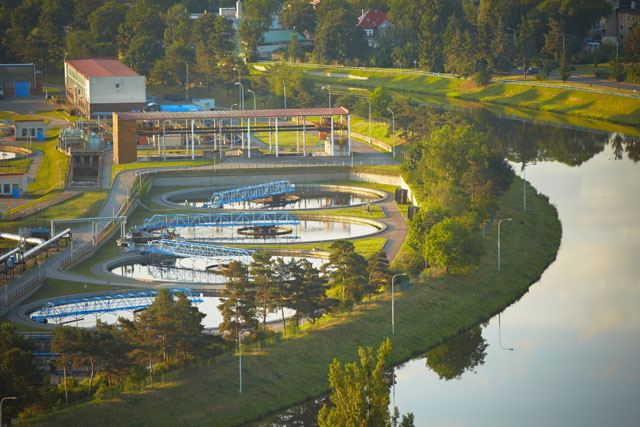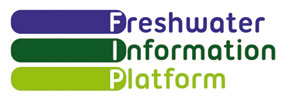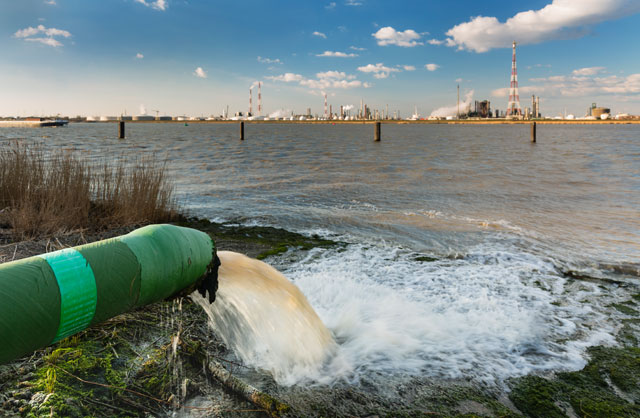Point Pressures
Point source pressures are generated from fixed, identifiable sources and sites such as water treatment works, industrial plants and fish farms, often to a specific outflow pipe or channel. The effects of such localised pollution pressures – such as the release of nutrients, chemicals, sewage or hazardous substances – can cause high stress levels to the immediate environment, potentially causing fish kills, eutrophication and threats to human health.

Urban Waste Water Treatment plan near Prague

Contaminated water due to industrial pollution in Spanish river
Pressure types
There are a number of point source pressures generated by different drivers:
Urban development
Urban waste water – the waste products generated by urban populations – sewage, chemicals, microplastics and so on – and emitted into the water system can cause multiple stresses on nearby water bodies unless appropriately treated. Sewage treatment plants themselves can also emit point source pollution with high nutrient levels.
Waste disposal sites – landfills and other waste disposal sites – both active and non-active – can generate wastewater with high concentrations of nutrients, chemicals and harmful microbes produced through decomposition.
Industry
Industrial pollution – the waste products from industrial processes – particularly ‘heavy’ industries such as oil refineries, steel works, plastic and chemical manufacturers – are often numerous, with many new chemical compounds and toxins being generated and emitted each year. Industrial processes also bring the risk of accidental spills of pollutants such as oil and fuel.
Contaminated and abandoned industrial sites – ex-industrial sites often contain residual pollutants – chemicals, toxins, metals – which may be transported into water bodies through existing pipelines and channels, particularly during times of heavy rainfall.
Mine waters – water which collects underground in active mines is often brought to the surface for disposal. Depending on the mined material, this wastewater can contain high levels of metals, sulphide minerals, dissolved solids, or salts, and as such requires appropriate treatment before disposal.
Aquaculture
Aquaculture pollution - farming fish in both freshwater and transitional waters generates high levels of nutrient waste, which if not adequately contained, recycled or treated, may reach surrounding water bodies.
Geographical distributions and trends
Across Europe, between 5-10% of lakes, 20-25% of rivers and 46% of transitional waters are subject to point source pollution (EEA 2012). Point pressures have largely declined across Western Europe in the last 30 years (EEA 2007), due to improved wastewater and sewage treatment processes, coupled with targeted European policies such as the Urban Waste Water Treatment Directive (UWWTD 2015) and the Industrial Emissions Directive (EEA 2008, 2014). However, the percentage of rivers, lakes and transitional waters affected by combined point source and diffuse pollution pressures remains highest in Northern and Western Europe, particularly Eastern England, Northern France, Northern Germany, Belgium, Netherlands and Sweden (Deltares 2013, EC 2012).
Stressors generated
Point source pressures predominantly generate chemical stressors, including nutrient pollution and the emission of toxic, radioactive and chemical substances. Industrial wastewater may be of a higher temperature than the water body, potentially causing thermal stressors. In smaller streams and lakes, the force of the wastewater outflow itself may generate additional hydrological stressors.
Potential for mitigation
The key mitigation strategy for reducing point source pressures is to adequately treat waste products before they enter a water body, or to prevent their emission entirely. This may be implemented through: the development and implementation of effective wastewater and sewage treatment processes such as ‘Fourth Treatment Stage’ processes; better policy regulation of allowable pollutant concentrations and subsequent monitoring and enforcement; the advancement of closed-loop industrial and aquaculture practices that recycle waste-water; and improvements to the capacity of stormwater and sewage networks in urban areas to prevent overflow during high rainfall.
Further reading
Reports and publications:
Deltares (2013). Diffuse water emissions in E-PRTR - Project Report (Download report, 2mb)
EEA (2007). Point sources (Download report, 91kb)
EEA (2012). European waters - assessment of status and pressures (Download report, 28mb)
EEA (2014). Water: nutrient and heavy metal pollution 'decoupling' from growth (Download report, 200kb)
EEA (2015). Waterbase - UWWTD: Urban Waste Water Treatment Directive – reported data (Download report, 142kb)
Selected Freshwater blogs:
Freshwaterblog (2014). Chemical pollution threatens Europe’s freshwaters (External website)
Freshwaterblog (2016). Can we geo-engineer polluted freshwaters back to health? (External website)
Freshwaterblog (2016). Assessing and managing chemical pollution: towards the 2019 review of the European Water Framework Directive (External website)
Freshwaterblog (2016). A snapshot of the world’s water quality: water pollution increases in Africa, Asia and Latin America (External website)
Freshwaterblog (2017). SOLUTIONS: Simplified sampling of large water volumes for combined chemical and biological testing (External website)
Other websites:
European Pollutant Release and Transfer Register (E-PRTR) (External website)





